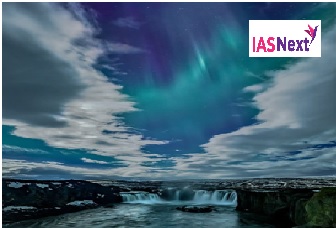CURRENT AFFAIRS
Get the most updated and recent current affair content on Padhaikaro.com
Aurora
- IAS NEXT, Lucknow
- 22, Apr 2022

Reference News:-
Stunning aurora glow was recently observed above Iceland after a ‘dead’ sunspot erupted.
What is Aurora?
An Aurora is a display of light in the sky predominantly seen in the high latitude regions (Arctic and Antarctic). It is also known as a Polar light.
Types:
There are two types- the aurora borealis and aurora australis – often called the northern lights and southern lights.
Where do they occur?
They commonly occur at high northern and southern latitudes, less frequent at mid-latitudes, and seldom seen near the equator.
Colors:
While usually a milky greenish color, auroras can also show red, blue, violet, pink, and white. These colors appear in a variety of continuously changing shapes.
Science behind their occurrence:
- Auroras are a spectacular sign that our planet is electrically connected to the Sun. These light shows are provoked by energy from the Sun and fueled by electrically charged particles trapped in Earth’s magnetic field.
- The typical aurora is caused by collisions between fast-moving electrons from space with the oxygen and nitrogen in Earth’s upper atmosphere.
- The electrons—which come from the Earth’s magnetosphere, the region of space controlled by Earth’s magnetic field —transfer their energy to the oxygen and nitrogen atoms and molecules, making them “excited”.
- As the gases return to their normal state, they emit photons, small bursts of energy in the form of light.
- When a large number of electrons come from the magnetosphere to bombard the atmosphere, the oxygen and nitrogen can emit enough light for the eye to detect, giving us beautiful auroral displays.
Where do they originate?
They origin at altitudes of 100 to more than 400 km.
Why do auroras come in different colors and shapes?
- The color of the aurora depends on which gas — oxygen or nitrogen — is being excited by the electrons, and on how excited it becomes. The color also depends upon how fast the electrons are moving, or how much energy they have at the time of their collisions.
- High energy electrons cause oxygen to emit green light (the most familiar color of the aurora), while low energy electrons cause a red light. Nitrogen generally gives off a blue light.
- The blending of these colors can also lead to purples, pinks, and whites. The oxygen and nitrogen also emit ultraviolet light, which can be detected by special cameras on satellites.
Effects:
- Auroras affect communication lines, radio lines and power lines.
- It should also be noted here that the Sun’s energy, in the form of solar wind, is behind the whole process.